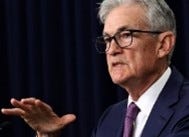When the monkey business goes wrong....
The story of man unkind - Who ya gonna believe? Me or your own lyin eyes?
Congratulations on surviving this epic series. Welcome to the epilogue.
What does all of this mean in practice?
A number of informed observers have recently coalesced around the idea that the Fed’s institutionalised biases are causing them to delay policy easing for too long, with potentially disastrous consequences. Ex-Fed staffer Claudia Sahm has long wanted to adopt ‘automatic stabilisers’ to prevent the risk of policy mistakes. In other words, when conditions reach a certain level of deterioration, certain actions of policy easing should kick in. Sadly, Claudia’s proposals have not been adopted. Even more sadly, we have long past the point at which conditions would be so bad that policy easing would be automatically triggered, placing reliance on less than competent individuals to act:
“The Fed should start its path back to normal by cutting the federal funds rate. The progress already made on inflation justifies a first cut. Personal Consumption Expenditure (PCE) inflation is within ½ percentage point of its target, while the federal funds rate remains more than three percentage points higher than before the pandemic. The outlook for inflation and the lags in monetary policy strengthen the case further to beginning a gradual easing….Good monetary policy doesn’t hold off for urgent circumstances. Good policy is forward-looking and balanced; as inflation normalizes, so should the Fed.” – Claudia Sahm
Claudia explains why the Fed should not delay rate cuts (we think that it may already be too late to prevent recession) :-
“
The lower-than-expected inflation data since the June meeting returned to disinflation and confirmed that some of the inflation early in the year was likely due to calendar effects and one-off increases, not an underlying re-acceleration.
The monthly pace of rent of shelter inflation (tenant and owners’ equivalent) moved down to its pre-pandemic pace, which should be an important source of further disinflation in the outlook in the second half.
Wage growth—while still above the pre-pandemic pace—has moderated. A better balance between the supply of and demand for workers reduces cost pressures, reducing an upside risk to inflation.
Industry reports and the Fed’s Beige Book suggest that consumers are becoming more price-sensitive again, which limits businesses’ ability to raise prices.
Data, outlook, risk, and behavior all point to sustainable progress toward the 2% inflation target and to gradually normalizing monetary policy….
Waiting may make it harder to cut gradually and could create unwarranted urgency. Even so, some hawkish aftertaste will probably remain. Why?
The Fed is not confident about inflation. They want more data. The bar for “confidence” is high, and some hurdles, like ‘base effects’ in inflation, may make it harder to build more confidence in the data in the second half.
The Fed does not want to appear weak on inflation, or to cut on concerns about the labor [sic] market. No one wants to be Arthur Burns. The Fed’s test of “significant deterioration in the labor [sic] market” is likely significantly weaker than outsiders.’
The markets have more than fully priced in a 25-basis point rate cut in September. While that’s not where the Fed’s thinking likely is, they have no reason to push back the market view tomorrow aggressively. It is close enough, and the data can do the work if necessary.
The Fed is missing an opportunity to cut that rests credibly on disinflation. It wants more data. It even seems to want urgency to force a move. It might get it, but that would be unfortunate.” – Claudia Sahm
“Who ya gonna believe? Me or your own lyin eyes?”
(How we imagine Jerome Powell channelling his inner Chico Marx)
Jerome Powell is a Chico Marxist!
“Using the latest unemployment and inflation numbers, we estimate that the median of the Fed staff’s monetary policy rules now implies a funds rate of 4%, well below the actual rate of 5¼-5½%.....If the case for a cut is clear, why wait another seven weeks before delivering it?”
– Jan Hatzius, Goldman Sachs
“Comparing the current policy rate to a range of prescriptions of Taylor-type rules suggests – hypothetically – that current policy is too restrictive. Specifically, the moderation of inflation over the last two years, along with the modest rise in unemployment, argues for the policy rate to be around 200 basis points lower than it is today, according to simple prescriptive rules” – PIMCO Macro Outlook:
Summary
The events in investment markets last week broadly reflected the sudden realisation that the majority of market participants may have been too complacent in relying on policymakers to deliver rose-tinted outcomes. The data that had been indicating this suddenly, because of an out of step action by the Bank of Japan in raising interest rates more than had been expected, hit markets with a very hard dose of reality. However, soothing words and a more upbeat, albeit misleading, data point about US labour conditions has allowed investors to carry on believing that all is once again rosy in the capital market garden, despite the considerable indications that this is not the case. If market wishful thinking turns out to be justified, then the melt-up in tech and AI might be expected to resume. If not, then precious metals (and mining companies), US treasuries and the Yen may be reasonable safe havens.
MBMG Investment Advisory is licensed by the Securities and Exchange Commission of Thailand as an Investment Advisor under licence number Dor 06-0055-21.
For more information and to speak with our advisors, please contact us at info@mbmg-investment.com or call on +66 2 665 2534.
About the Author:
Paul Gambles is licensed by the SEC as both a Securities Fundamental Investment Analyst and an Investment planner.
Disclaimers:
1. While every effort has been made to ensure that the information contained herein is correct, MBMG Investment Advisory cannot be held responsible for any errors that may occur. The views of the contributors may not necessarily reflect the house view of MBMG Investment Advisory. Views and opinions expressed herein may change with market conditions and should not be used in isolation.
2. Please ensure you understand the nature of the products, return conditions and risks before making any investment decision.
3. An investment is not a deposit; it carries investment risk. Investors are encouraged to make an investment only when investing in such an asset corresponds with their own objectives and only after they have acknowledged all risks and have been informed that the return may be more or less than the initial sum.








